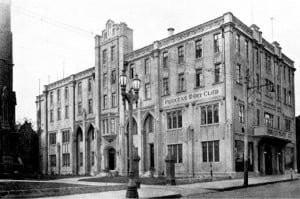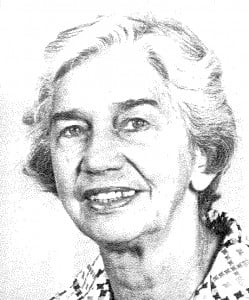Janice Chandler remembers the career of Ailsa Trundle, one of Australia’s remarkable early women architects and one of the first to become a full partner in an architectural practice.
Ailsa Merle Trundle was born on August 9, 1916 in Murwillumbah, New South Wales. In 1933 her banker father, Joseph Trundle (1886 – 1946), moved the family to Bendigo, Victoria, where Ailsa attended Bendigo High School. After leaving high school Ailsa told her parents she wanted to study architecture. It was 1934 and if they were concerned about her choice to make her mark in such male-dominated profession there was no apparent attempt to dissuade her.
Ailsa spent the next three years at the Bendigo School of Mines where she studied art and science before gaining her Diploma of Architecture at Geelong’s Gordon Institute of Technology. This was followed by four years at Melbourne University Architectural Atelier where she attended lectures four nights a week while working in an architectural practice during the day. (Finding a practice prepared to employ a woman was extremely difficult but her perseverance finally paid off when she was offered a position with L. Hume Gerrard).


Like so many young women from the country Ailsa rented a room at the Princess Mary Club (the Wesley Central Girls’ hostel), which had opened in 1926. The room was very poorly heated and Ailsa’s visitors often found her sitting on her bed wrapped in blankets, drawing board on her knees, valiantly working through the night to meet Atelier’s deadlines.
Students attending Atelier in those pre-war times worked extremely hard but the money they earned was never commensurate with their workload. Close friendships were forged between the students many of whom were members of the Victorian Architectural Students’ Society and produced their own magazine Smudges. Magazine founder Robin Boyd wrote “every editorial and in each issue singled out buildings for either a ‘blot’ or a ‘bouquet’”!1
When Ailsa graduated her prospect of finding work was somewhat improved because many of her male colleagues had been drafted to work for the war effort. Also in her favour was the pay rate for women that had been brought in line with men, an equal pay policy which remained in place until 1949.
Ailsa Trundle and Elizabeth Hope were the only women in a group of ten approved for nomination as members of the Students’ Society of the Royal Victorian Institute of Architects in August 1938.2
In 1943 Ailsa joined R. S. Demaine (Robert Snowden Demaine 1895 – 1986) as a junior partner and in the same year became a member of the Royal Australian Institute of Architects. Four years later she was offered a full partnership by R. S. Demaine.
One of Ailsa’s first projects was designing her own home, which she did in 1945. It was, according to her, a far greater challenge than designing hospitals or nursing homes! She described the house in Surrey Hills – which she shared with her brother Keith (a civil engineer) who often designed the structures for the buildings she planned, and with her mother (Charlotte Trundle) – as “just modern and functional with lots of windows”. This matter-of-fact response was very typical of Ailsa who was never a verbose woman or someone who actively sought the limelight.
Charlotte Trundle had moved in with Ailsa at Surrey Hills after the sudden death of her husband Joseph in Launceston, Tasmania, in April 1946. Joseph Trundle died 10 days after becoming ill and just several weeks before his 60th birthday and retirement from the Bank of Australasia.
Demaine and Trundle amalgamated with Russell, Armstrong and Orton in 1957. Ailsa was the only female director and she remained a director of the company until she retired. When Demaine, Russell, Trundle, Armstrong & Orton moved to 1 Darling Street, South Yarra, she helped to design the offices and was responsible for the interior design.
Ailsa and seven of her male counterparts were made fellows of the Royal Victorian and Royal Australian Institute of Architects in 1963. In a newspaper article reporting the event, Ailsa said “Fellowship denotes seniority in the profession – provided you are a good soul and have designed a reasonable number of reputable buildings you can be made a fellow”. She was the sixth Australian woman accorded the honour.
Ailsa Trundle was a pioneer in her field. A very successful and inspirational woman whose example no doubt inspired many young women to choose architecture as a profession.
Ailsa said “…if given a choice, she designed buildings for welfare work, including hospitals, homes for the aged and for children, in preference to banks and offices.” She believed there was “more scope for woman in that type of design work because they understood the needs of the client better than men did.”
Two organisations that were extremely important to her were the Melbourne Quota Club, an organization for female business executives, and the Lyceum Club, a club for university educated women.
She served two terms as president of the Melbourne Quota Club and during her membership of the Lyceum Club she met two extremely influential women who became her mentors. They were Ellison Harvie – (the first woman elected to an architectural institute council (1942) who also shared Ailsa’s passion for welfare and hospital design – and Cynthia Teague, MBE, who was supervising architect with the Commonwealth Department of Works (1960) and assistant director-general of the department (1964) – the first woman in Australia elevated to the second division of the public service.
When I knew Ailsa, she was an attractive woman with wavy grey hair, well-defined dark eyebrows, and a very hearty infectious laugh. She was tall, with an athletic build. It was true to say she did not suffer fools gladly and expected those in her employ to work as hard as she did while making the least possible number of mistakes. Although a very private person, Ailsa showed great compassion for your widowed mother, taking her in after the sudden death of her father.
Her office at 1 Darling Street, South Yarra, was always meticulously neat, and next door to fellow director Robert Snowden Demaine, 21 years her senior and her greatest advocate. Ailsa Trundle and Bob Demaine had a very good working relationship and a friendship which endured until Bob’s passing in 1986. He greeted her affectionately as “Miss” and she called him “Sir”!
When asked about the role of women in architecture Ailsa said, “Women had a very definite place in the architectural profession… they could design houses or they might be accepted into welfare-type work. They were definitely not accepted into factory design or city office buildings or anything like that”. When she was interviewed for Trust News in 1990 she said, “I always felt that welfare work is the human side of architecture against the more powerful, brittle side, which I never find attractive.”
Organisations that she designed facilities for included the Autistic Children’s Association at three different sites, the Presbyterian home for the aged at West Preston (Lumeah), Greenvale Geriatric Centre, Carnsworth Garoopna Nursing Home in Kew, and Dalkeith Home for the Aged in Traralgon. She was also honorary architect for the Nurses’ Memorial Centre in St Kilda Road, Melbourne. Her hospital projects included Morwell and District, Gisborne and District Bush Nursing, Wodonga and District, but probably her proudest achievement was her work at Central Gippsland Hospital, Traralgon, over an association which spanned her career.
Ailsa Merle Trundle, Architect, died on 26 April 2002 aged 85. She was a woman whose body of work in the health and welfare sector was significant, she made junior partner at 30 and was the only female partner of a highly regarded Melbourne architectural company from 1957 until she retired at 65.
Note: Janice met Ailsa Trundle in December 1969 when she applied for an admin position at R. S. Demaine, Russell, Trundle, Armstrong & Orton. She got to know Ailsa in a professional capacity during the six years she spent with the company.
- Robin Gerard Penleigh Boyd (1919–1971) by Neil Clerehan published in Australian Dictionary of Biography, Volume 13, (MUP), 1993.[↩]
- Argus newspaper 18 August 1938.[↩]





















